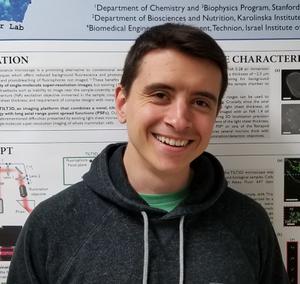ESP Biography
PETAR PETROV, Chemistry PhD student
|
Major: Chemistry College/Employer: Stanford Year of Graduation: 2020 |

|
Brief Biographical Sketch:
I'm a PhD student in the chemistry department at Stanford. I came here to do some sort of interdisciplinary physical/chemical science and wound up working in a relatively new field called "single-molecule imaging," which combines concepts from chemistry, physics, biology, math, and engineering all into one to look at the world one molecule at a time. I'm excited to tell you about it! Past Classes(Clicking a class title will bring you to the course's section of the corresponding course catalog)C7388: A single molecule: the smallest thing you can see in Splash Fall 2019 (Nov. 16 - 17, 2019)
Have you ever wondered what a molecule looks like? In this course, we’ll learn how we can use an optical microscope to see individual molecules. To understand how this works, we’ll learn about lenses and look at what all the parts of a microscope do. Then, we’ll explore the concept of diffraction and how it affects what we see in the microscope. We’ll see how some molecules radiate light by a process called fluorescence, and how we can use that light to see a single molecule even though it’s surrounded by millions of other molecules. Finally, we’ll learn about a Nobel Prize-winning technique called super-resolution imaging, which combines all these big ideas to look at biological structures like DNA, mitochondria, and the cell membrane one molecule at a time.
C7023: A single molecule: the smallest thing you can see in Splash Spring 2019 (May. 04 - 05, 2019)
Have you ever wondered what a molecule looks like? In this course, we’ll learn how we can use an optical microscope to see individual molecules. To understand how this works, we’ll learn about lenses and look at what all the parts of a microscope do. Then, we’ll explore the concept of diffraction and how it affects what we see in the microscope. We’ll see how some molecules radiate light by a process called fluorescence, and how we can use that light to see a single molecule even though it’s surrounded by millions of other molecules. Finally, we’ll learn about a Nobel Prize-winning technique called super-resolution imaging, which combines all these big ideas to look at biological structures like DNA, mitochondria, and the cell membrane one molecule at a time.
C6876: A single molecule: the smallest thing you can see in Splash Fall 2018 (Dec. 01 - 02, 2018)
Have you ever wondered what a molecule looks like? In this course, we’ll learn how we can use an optical microscope to see individual molecules. To understand how this works, we’ll learn about lenses and look at what all the parts of a microscope do. Then, we’ll explore the concept of diffraction and how it affects what we see in the microscope. We’ll see how some molecules radiate light by a process called fluorescence, and how we can use that light to see a single molecule even though it’s surrounded by millions of other molecules. Finally, we’ll learn about a Nobel Prize-winning technique called super-resolution imaging, which combines all these big ideas to look at biological structures like DNA, mitochondria, and the cell membrane one molecule at a time.
|
|
